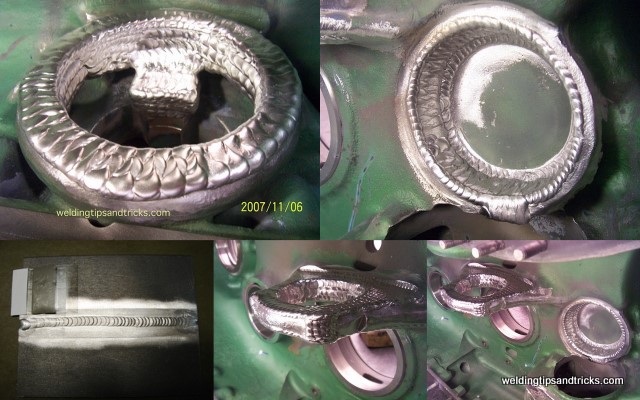Welding Magnesium - and other Tig Welding Techniques
Another Video in the Series "metals and how to weld them"
Read all the osha safety stuff before welding magnesium
"Magnesium is a weird metal...you can bury the arc and not crap up the tungsten "

Metals and properties of Carbon Steel
properties of stainless part 1
properties of stainless part 2 purging stainless steel
properties of nickel alloys
properties of aluminum
Magnesium Welding - Tig Welding Magnesium Castings
Repairs are mostly done using Tig, although welding magnesium can be done with other methods.
A great deal of Magnesium Welding is done to repair castings. Not to join 2 pieces of metal together.
Building up worn metal, replacing a broken lug with weld beads, repairing pits, inclusions, and other casting defects are all more common than joining pieces of magnesium together.
Magnesium is used quite a bit in aircraft components because of its high strength to weight ratio.
Magnesium castings are lightweight and strong, but they do crack and break in service due to all kinds of factors like thermal cycles, vibration, and just plain human factors like a mechanic over torquing a stud.
An aircraft gearbox made from magnesium might cost upwards of $50,000 dollars so being able to make a weld repair is often an economical way to repair magnesium casting.
One of the biggest hurdles in welding magnesium castings like this is that they are often oil soaked. The oil that lubricates the gears, shafts, and bearings stays in contact with the inside of the gearbox during many many heating and cooling cycles and so the pores on the metal soak up oil like a sponge.
You can actually see it weep out of the metal by heating the metal with a torch.
Another problem is high zinc content. Magnesium alloys that have a zinc content of 5-6% are crack sensitive and dont weld nearly as good as the ones that have about 10% aluminum content along with lower zinc.
AZ101 magnesium filler rod is considered one the most forgiving fillers and the reason why is that it fits the description I just gave....about 10% aluminum with a maximum zinc content of 1.25 %.
Like Aluminum, Magnesium comes in different alloys and some alloys can be strengthened by heat treatment and some cant.
And just like Aluminum alloys that have been heat treated to improve properties...Getting a magnesium casting too hot during the welding process can remove strength.

Safety for Welding Magnesium
Read what Osha says beore Welding Magnesium In addition to all the normal precautions for general welding, there are some extra ones for magnesium welding.
* make sure to have a class D fire extinguisher close by and also a bucket of plain sand * clean as you go...if you create grinding dust or shavings, these are like kindling. keep the work area clean * make sure you have proper ventilation. and remember that magnesium dust and fine particles can ignite so sometimes special ventilation systems are required to minimize this risk
Down and Dirty Tips for welding magnesium castings
* clean as good as you can with acetone and a carbide burr.... a coarse burr that wont load up.
* often, filler rod choice is governed by a written procedure according to the composition of the magnesium alloy base metal... but if you have the option, use az101 filler rod
* preheat thick parts to around 300f
* use same tig machine settings as for aluminum, except that a 50/50 argon/helium mix makes a huge difference.
* light up and increase amperage until it barely puddles. if it does not puddle clean, stop, burr, wire brush, repeat as many times as necessary to get it to puddle clean
* oil gets into the pores of this stuff and it takes a while sometimes to get enough out to weld clean
* use a much closer arc length than for aluminum...like so close that you think its too close.
* weld small beads and clean in between with your small 90 air grinder and a carbide burr and then a stainless wire brush.
exit welding magnesium go to home page
go to main tig welding page















